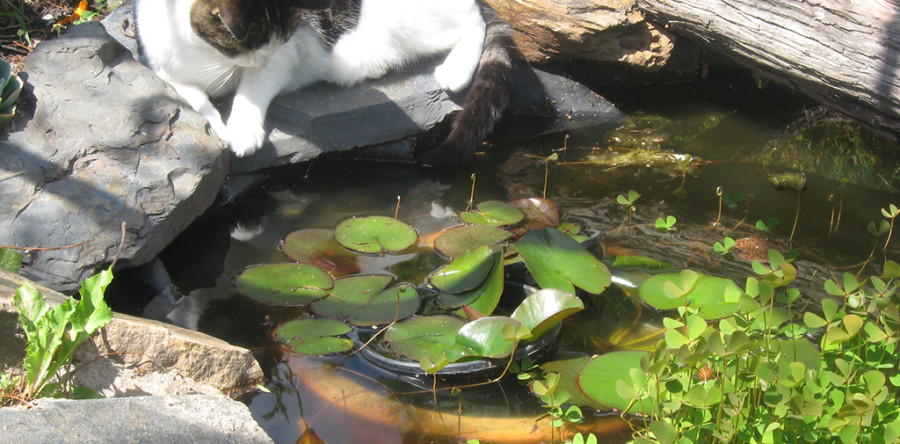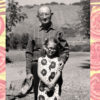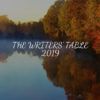Reflections on a Pond
May 13, 2015
When my son, Leo, left for college, I restored my backyard pond. Suddenly, I had the time to focus on landscaping. More than that, replacing the 20 year old pond was a not-so-subtle way of expressing that in some respects I was back to where I’d been before the birth of my only child.
A long time had passed since I’d taken a shovel to the middle of my flat yard and declared that here would be the water feature my new garden required. A passionate novice, I was an ambitious and fearless gardener, though also one on a budget. Hardly bigger than a puddle, my pond nevertheless flourished with waterlilies on the surface, parrot’s feather underwater for oxygenation, and 50 cent goldfish from Woolworth’s darting between the plants. Never mind that the pond seemed to have been plunked down in the middle of my lawn, or that raccoons often slashed the lily pads to shreds and that my husband’s long hours away meant that he never saw the flowers open to the sun, unless they happened to bloom on the weekend. I enjoyed my pond and so did the cats, who avidly watched the fish without ever jumping in after them.
Babies aren’t as clever as cats, though. After Leo was born, I knew my pond had become problematic and that I must come up with a solution before he started crawling. Rather than cover the pond, I converted it to a sandbox, removing the water and partly filling the hole with newspapers before adding play sand. Soon Leo was dragging dump trucks across his new sandbox or, more accurately, sandpit.
Despite my mother-in-law’s predictions, he never fell and hit his head on the rocks that hid the pond liner’s edge. Nor did the cats mistake the play space for a litter box, perhaps because they enjoyed rolling in the hot sand and sharpening their claws on the piece of driftwood I’d placed nearby.
For the first few years, the sandpit filled with water during heavy storms, but that didn’t matter. Leo, dressed in rain boots, found the giant puddle as amusing as dry sand. I simply refreshed the sand in the spring. Eventually the liner must have sprung a leak, because the flooding stopped.
I can’t remember when I realized that Leo hadn’t been near the sandbox in months. Those were busy years. The entire garden looked a bit neglected during that period, so at first I didn’t notice that the sand was dirty and compacted, the plastic sand toys sun-bleached.
By the time Leo entered middle school, the eyesore in the middle of the backyard needed to be confronted. Since the area drained slowly, I began to call it the bog. I even bought bog plants and tucked them into the muddy sand. However, my bog project was never more than a half-hearted effort, and I began to dream of replacing the pond.
Finally, I found the time to do it. First I was an archaeologist digging through the layers of our lives, excavating mud, then sand, unburying a red shovel, a ball, a plastic frog, reaching the layers of newspaper, still legible and dated 1995, and finally peeling out the old, cracked liner. Then I took stock.
Two decades had passed, but my back and arms held up pretty well to digging. Perhaps to prove to myself that I could still be ambitious and a little crazy I decided to enlarge the pond before laying down a new liner. To refresh my memory of how to do it, I watched instructional YouTube videos, instead of checking out library books as I had the first time around in pre-Internet days.
In some ways I was coming full circle. In others, I was moving on. Rather than stock my rejuvenated pond with tropical lilies, I used hardier plants and natives for a more raccoon-friendly pond. I set a long branch in the water at an angle to allow animals to go in and, more importantly, to get out. I also decided to forgo fish, since they eat dragonfly eggs and nymphs. I wasn’t sure if I’d changed or if my choices reflected changes in society, but I knew I wanted my revitalized pond to be as natural and sustainable as possible.
For several years, I’d been replacing parts of my lawn with ground covers and gravel and I continued to do that as I landscaped around my pond. Before, grass surrounded it on all sides. Now, a gravel path curves behind and a tiny sand beach fronts it. Not only is this arrangement more water-thrifty, it also links the pond more gracefully to the rest of the garden.
At first, before the plants grew up and shaded the water, algae appeared. So did tiny, thrashing mosquito larvae. I used mosquito dunks. Mostly, I waited for the pond to mature.
Two years later, the plants are thriving, mostly. Raccoons seem to enjoy decapitating papyrus. But orange dragonflies perch on the half-submerged log, while blue damselflies skim the water. It’s quiet out there, now. The garden is tidy, the only toy in sight the small red wagon I’ve turned into a planter.
With Leo gone and the pond restored, I might be excused for feeling that I am right back where I started. All I have to do, though, is to look out at the backyard to see that this isn’t the case at all. The pond is back again, but it’s a different pond. It’s better.
(A shorter version of this essay first appeared in Horticulture Magazine.)





